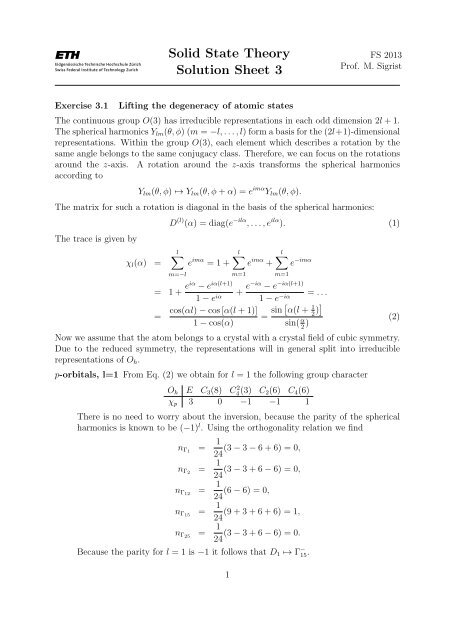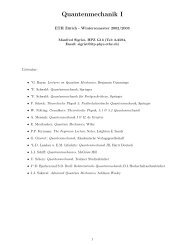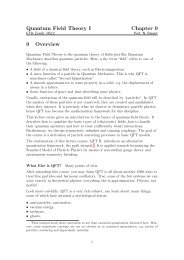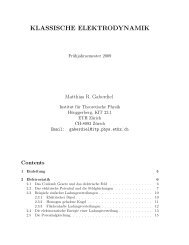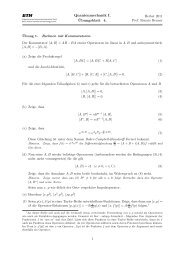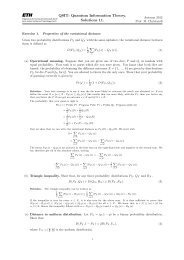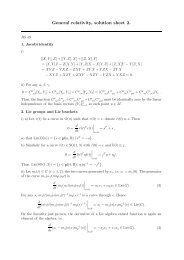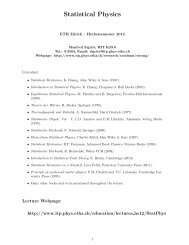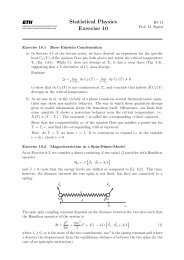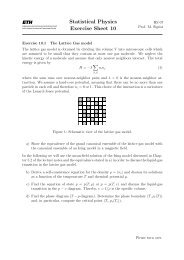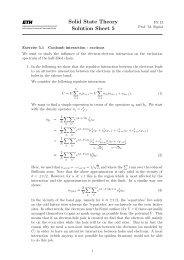Solid State Theory Solution Sheet 3
Solid State Theory Solution Sheet 3
Solid State Theory Solution Sheet 3
Create successful ePaper yourself
Turn your PDF publications into a flip-book with our unique Google optimized e-Paper software.
<strong>Solid</strong> <strong>State</strong> <strong>Theory</strong><br />
<strong>Solution</strong> <strong>Sheet</strong> 3<br />
FS 2013<br />
Prof. M. Sigrist<br />
Exercise 3.1<br />
Lifting the degeneracy of atomic states<br />
The continuous group O(3) has irreducible representations in each odd dimension 2l + 1.<br />
The spherical harmonics Y lm (θ, φ) (m = −l, . . . , l) form a basis for the (2l+1)-dimensional<br />
representations. Within the group O(3), each element which describes a rotation by the<br />
same angle belongs to the same conjugacy class. Therefore, we can focus on the rotations<br />
around the z-axis. A rotation around the z-axis transforms the spherical harmonics<br />
according to<br />
Y lm (θ, φ) ↦→ Y lm (θ, φ + α) = e imα Y lm (θ, φ).<br />
The matrix for such a rotation is diagonal in the basis of the spherical harmonics:<br />
The trace is given by<br />
χ l (α) =<br />
D (l) (α) = diag(e −ilα , . . . , e ilα ). (1)<br />
l∑<br />
m=−l<br />
e imα = 1 +<br />
l∑<br />
e imα +<br />
m=1<br />
l∑<br />
m=1<br />
e −imα<br />
= 1 + eiα − e iα(l+1)<br />
+ e−iα − e −iα(l+1)<br />
= . . .<br />
1 − e iα 1 − e −iα<br />
=<br />
cos(αl) − cos [α(l + 1)]<br />
1 − cos(α)<br />
= sin [ α(l + 1 2 )]<br />
sin( α 2 ) (2)<br />
Now we assume that the atom belongs to a crystal with a crystal field of cubic symmetry.<br />
Due to the reduced symmetry, the representations will in general split into irreducible<br />
representations of O h .<br />
p-orbitals, l=1 From Eq. (2) we obtain for l = 1 the following group character<br />
O h E C 3 (8) C 2 4(3) C 2 (6) C 4 (6)<br />
χ p 3 0 −1 −1 1<br />
There is no need to worry about the inversion, because the parity of the spherical<br />
harmonics is known to be (−1) l . Using the orthogonality relation we find<br />
n Γ1 = 1 (3 − 3 − 6 + 6) = 0,<br />
24<br />
n Γ2 = 1 (3 − 3 + 6 − 6) = 0,<br />
24<br />
n Γ12 = 1 (6 − 6) = 0,<br />
24<br />
n Γ15 = 1 (9 + 3 + 6 + 6) = 1,<br />
24<br />
n Γ25 = 1 (3 − 3 + 6 − 6) = 0.<br />
24<br />
Because the parity for l = 1 is −1 it follows that D 1 ↦→ Γ − 15.<br />
1
d-orbitals, l=2 In the same way we find for l = 2<br />
and<br />
O h E C 3 (8) C 2 4(3) C 2 (6) C 4 (6)<br />
χ d 5 −1 1 1 −1<br />
n Γ1 = 1 (5 − 8 + 3 + 6 − 6) = 0,<br />
24<br />
n Γ2 = 1 (5 − 8 + 3 − 6 + 6) = 0,<br />
24<br />
n Γ12 = 1 (10 + 8 + 6) = 1,<br />
24<br />
n Γ15 = 1 (15 − 3 − 6 − 6) = 0,<br />
24<br />
n Γ25 = 1 (15 − 3 + 6 + 6) = 1.<br />
24<br />
Since the parity is now positive it follows that D 2 ↦→ Γ + 12 ⊕ Γ + 25.<br />
f-orbitals, l=3<br />
This yields<br />
O h E C 3 (8) C 2 4(3) C 2 (6) C 4 (6)<br />
χ f 7 1 −1 −1 −1<br />
n Γ1 = 1 (7 + 8 − 3 − 6 − 6) = 0,<br />
24<br />
n Γ2 = 1 (7 + 8 − 3 + 6 + 6) = 1,<br />
24<br />
n Γ12 = 1 (14 − 8 − 6) = 0,<br />
24<br />
n Γ15 = 1 (21 + 3 + 6 − 6) = 1,<br />
24<br />
n Γ25 = 1 (21 + 3 − 6 + 6) = 1.<br />
24<br />
Because of the negative parity we obtain D 3 ↦→ Γ − 2 ⊕ Γ − 15 ⊕ Γ − 25.<br />
Eigenfunctions of the d-orbitals We know that D 2 ↦→ Γ + 12 ⊕ Γ + 25, where Γ + 12 and Γ + 25<br />
are two- and three-dimensional representations, respectively. It is also known that<br />
the spherical harmonics for l = 2 form a basis for the harmonic, homogeneous<br />
polynomials of order 2. Such a polynomial can be written as<br />
P = c 1 xz + c 2 xy + c 3 yz + c 4 (x 2 − z 2 ) + c 5 (y 2 − z 2 ), (3)<br />
where it is implicitly assumed that x 2 + y 2 + z 2 = 1. Now let us consider a rotation<br />
around the z axis by π/2. Thus, z ↦→ z, x ↦→ y and y ↦→ −x. This yields<br />
xz ↦→ yz, xy ↦→ −xy, yz ↦→ −xz,<br />
x 2 ↦→ y 2 , y 2 ↦→ x 2 , z 2 ↦→ z 2 .<br />
2
We see that the triple {xz, xy, yz} and the pair {x 2 − z 2 , y 2 − z 2 } do not mix under<br />
this transformation.<br />
Therefore, {xz, xy, yz} = { cos φ sin θ cos θ, cos φ sin φ sin 2 θ, sin φ sin θ cos θ } is a basis<br />
for Γ + 25 and {x 2 − z 2 , y 2 − z 2 } = {cos φ 2 sin θ 2 − cos θ 2 , sin φ 2 sin θ 2 − cos θ 2 } is a<br />
basis for Γ + 12. Often, the two-dimensional subspace of Γ + 12 is called the e g subspace<br />
and the three dimensional subspace of Γ + 25 is called the t 2g subspace.<br />
Exercise 3.2<br />
Two-orbital tight-binding model in 2d<br />
a) The Bloch-waves constitute a basis of the (quasi-2-dimensional) Hilbert space of<br />
the system. Since the Wannier functions are the “Fourier-transforms” of the Blochwaves,<br />
they, too, span the whole Hilbert space. Thus, we can write<br />
H =<br />
∑<br />
〈w α (r − r j )|H|w α ′(r − r j ′)〉c † αj c α ′ j<br />
, (4)<br />
′<br />
α, α ′ , j, j ′<br />
which can be split in two terms as<br />
H = ∑ α<br />
H α + ∑ α≠α ′ H α,α ′. (5)<br />
Considering only intra-band hopping terms and restricting the sum to nearest neighbour<br />
terms, we obtain<br />
H α = ∑ j<br />
ε α c † αj c αj + (tx αc † α(j+ˆx) c αj + ty αc † α(j+ŷ) c αj<br />
+ h.c.) (6)<br />
with<br />
ε α =〈w α (r)|H|w α (r)〉, (7)<br />
t x α =〈w α (r − aˆx)|H|w α (r)〉, (8)<br />
t y α =〈w α (r − aŷ)|H|w α (r)〉. (9)<br />
Considering the overlap elements t x/y<br />
α<br />
for both bands, we recognize that<br />
t x p x<br />
= t y p y<br />
, (10)<br />
t x p y<br />
= t y p x<br />
(11)<br />
due to the symmetry properties of the lattice system and the atomic orbitals.<br />
b) If we approximate the Wannier functions (which are orthogonal to each other) by<br />
atomic (hydrogen) states (which are not orthogonal to each other), we choose the<br />
orientation of the orbitals such that<br />
{<br />
positive, x > 0,<br />
sign(w px (r)) =<br />
(12)<br />
negative, x < 0,<br />
{<br />
positive, y > 0,<br />
sign(w py (r)) =<br />
(13)<br />
negative, y < 0.<br />
3
=〈w py (r − aˆx)|ε py + ∑ j≠0<br />
=〈w py (r − aŷ)|ε py + ∑ j≠0<br />
Using H j=0 w α (r) = (H kin + V (r))w α (r) = ε α w α (r), we find for the matrix elements<br />
t x p x<br />
=〈w px (r − aˆx)|ε px + ∑ j≠0<br />
V (r − r j )|w px (r)〉 (14)<br />
t y p x<br />
=〈w px (r − aŷ)|ε px + ∑ j≠0<br />
V (r − r j )|w px (r)〉 (15)<br />
t x p y<br />
V (r − r j )|w py (r)〉 (16)<br />
t y p y<br />
V (r − r j )|w py (r)〉. (17)<br />
The main contribution to this matrix element comes from the region between the two<br />
lattice sites where the two orbitals have opposite sign. As ε α < 0 and V (r) < 0, we<br />
obtain that t x p x<br />
= t y p y<br />
> 0. For t y p x<br />
, the orbitals have the same sign and t y p x<br />
= t x p y<br />
< 0.<br />
Performing the Fourier transformation<br />
c αj = √ 1 ∑<br />
e −ik·r j<br />
c αk (18)<br />
N<br />
of the annihilation operators in the Hamiltonian, we obtain<br />
k<br />
H α = ∑ k<br />
ε α,k c † αk c αk<br />
(19)<br />
with<br />
ε px,k = ε + 2t 1 cos(k x a) − 2t 2 cos(k y a) (20)<br />
ε py,k = ε − 2t 2 cos(k x a) + 2t 1 cos(k y a) (21)<br />
where ε = ε px = ε py , t 1 = t x p x<br />
, and t 2 = −t y p x<br />
> 0. The band structure and the Fermi<br />
surface (ɛ F = ɛ for half-filling) are visualized in Fig. 1.<br />
c) We now also take into account the coupling between the different bands. The<br />
nearest neighbour hopping matrix elements between different bands vanishes due to<br />
the symmetry of the orbitals. Therefore, we have to consider next-nearest neighbour<br />
hopping between different bands. In the same way as before, we obtain<br />
H α,α ′ = ∑ j<br />
t + αα<br />
c † ′ α(j+ˆx+ŷ) c α ′ j + t− αα<br />
c † ′ α(j+ˆx−ŷ) c α ′ j<br />
+ h.c. (22)<br />
with<br />
t ± αα ′ =〈w α (r − a(ˆx ± ŷ)|H|w α ′(r)〉 (23)<br />
Due to symmetry properties and the analogue consideration as above, we obtain<br />
t + p xp y<br />
= t + p yp x<br />
= −t − p xp y<br />
= −t − p yp x<br />
≡ t 3 > 0. Performing a Fourier transform of the<br />
Hamiltonian, we obtain<br />
H α,α ′ = ∑ k<br />
−4t 3 sin(k x a) sin(k y a)c † αk c α ′ k . (24)<br />
4
1.0<br />
0.5<br />
0.0<br />
0.5<br />
1.0<br />
1.0 0.5 0.0 0.5 1.0<br />
1.0<br />
0.5<br />
0.0<br />
0.5<br />
1.0<br />
1.0 0.5 0.0 0.5 1.0<br />
Figure 1: The band structure in the absence of interband coupling is visualized by a 3d plot<br />
and contour plot of the two bands. Also shown is the Fermi surface (t 1 = 0.4, t 2 = 0.05).<br />
Defining g k = −4t 3 sin(k x a) sin(k y a), the complete Hamiltonian can be written as<br />
H = ∑ k<br />
( )<br />
c † T ( ) ( )<br />
p xk εpxk g k c pxk<br />
c † p yk<br />
g k ε pyk<br />
c pyk<br />
(25)<br />
such that to diagonalize the Hamiltonian, we have to find the Eigenvalues E ± k<br />
the matrix above determined by the equation<br />
of<br />
The calculation is straightforward and we obtain<br />
(ε pxk − E ± k )(ε p yk − E ± k ) − g2 k = 0. (26)<br />
E ± k = ε + (t 1 − t 2 )(cos(k x a) + cos(k y a)) (27)<br />
√<br />
± (t 1 + t 2 ) 2 (cos(k x a) − cos(k y a)) 2 + 16t 2 3 sin 2 (k x a) sin 2 (k y a).<br />
The resulting band structure and the Fermi surface (ɛ F<br />
plotted in Fig. 2.<br />
= ɛ for half-filling) are<br />
5
1.0<br />
0.5<br />
0.0<br />
0.5<br />
1.0<br />
1.0 0.5 0.0 0.5 1.0<br />
1.0<br />
0.5<br />
0.0<br />
0.5<br />
1.0<br />
1.0 0.5 0.0 0.5 1.0<br />
Figure 2: The band structure in the presence of interband coupling is visualized by a 3d<br />
plot and contour plot of the two bands. Also shown is the Fermi surface (t 1 = 0.4, t 2 =<br />
0.05, t 3 = 0.1).<br />
6


